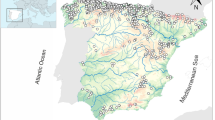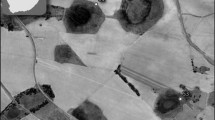Abstract
We assessed the importance of spatial scales (catchment, stream network, and sample reach) on the effects of agricultural land-use on lotic diatom assemblages along a land-use gradient in the agricultural Willamette Valley Ecoregion of Oregon. Periphyton, water chemistry, and physical habitat conditions were characterized for 25 wadeable streams during a dry season (July to September, 1997). Additional water chemistry samples were collected in the following wet season (February 1998) to assess seasonal effects of land-use on stream water chemistry. Percent agricultural land-use in the study catchments ranged from 10% to 89% with an average of 52%. Partial canonical correspondence analysis (CCA) with the first axis constrained by % agricultural land-use showed that % agricultural land-use at 3 spatial scales explained between 3.7%–6.3% of variability in the diatom species dataset. Monte Carlo Permutation tests indicated that the variance explained by % agricultural land-use was only significant at the spatial scale of the stream network with 10- and 30-m band width (p<0.05, 999 permutations). In addition to the effects of % agricultural land-use, partial CCAs with a forward selection option showed that water chemistry (e.g., SiO2), reach-scale stream channel dimensions (e.g., width, depth, and slope), reach-scale in-stream habitats (substrates and filamentous algal cover in stream beds), and riparian vegetative buffer were all important with relation to diatom species assemblages. Percent of obligately nitrogen-heterotrophic taxa was the only diatom autecological metric that showed a significant but weak correlation with % agricultural land-use along the stream network (r=0.50), but not at catchment or sample reach scale. Correlation between % agricultural land-use and water chemistry variables varied among the spatial scales and between seasons. Physical habitat variables (log10 erodible substrate diameters and stream reach slope) were significantly correlated with % agricultural land-use along the stream network but not at catchment or sample reach scale. Our data suggest that spatial scales are important in assessing effects of land-use on stream conditions but the spatial scale effects may vary between seasons. Direct linkages between agricultural land-use and lotic diatom assemblages were weak during summer base-flow time regardless of the spatial scales. Summer sampling may underestimate the effects of catchment land-use on stream conditions in areas where seasonal patterns are so distinctive as in the Willamette Valley.
Similar content being viewed by others
References
Allan, J. D., D. L. Erickson & J. Fay, 1997. Influence of catchment land-use on stream integrity across multiple spatial scales. Freshwater Biology 37: 149–161.
Allen, T. F. H., S. M. Bartell & J. F. Koonce, 1977. Multiple stable configurations in ordination of phytoplankton community change rates. Ecology 58: 1076–1084.
Anderson, J. R., E. E. Hardy, J. T. Roach & R. E. Witmer, 1976. A land-use and land cover classification system for use with remote sensor data. Professional Paper 964, U.S. Geological Survey, 28 p.
Arheimer, B. & R. Liden, 2000. Nitrogen and phosphorus concentrations from agricultural catchments-influence of spatial and temporal variables. Journal of Hydrology 227: 140–159.
Bahls, L. L., 1993. Periphyton Bioassessment Methods for Montana Streams. Water Quality Bureau, Department of Health and Environmental Sciences, Helena, Montana. (Available from: Water Quality Bureau, Department of Health and Environmental Sciences, Room A-206 Cogswell Building, 1400 Broadway, Helena, Montana 59620, U.S.A.)
Biggs, B. J. F. & R. A. Smith, 2002. Taxonomic richness of stream benthic algae: effects of flood disturbance and nutrients. Limnology and Oceanography 47: 1175–1186.
Blanchard, P. E. & R. N. Lerch, 2000. Watershed vulnerability to losses of agricultural chemicals: interactions of chemistry, hydrology, and land-use. Environmental Science and Technology 34: 3315–3322.
Bolstad, P. V. & W. T. Swank, 1997. Cumulative impacts of landuse on water quality in a southern Appalachian watershed. Journal of the American Water Resources Association 33: 519–533.
Bonn, B. A., S. R. Hinkle, D. A. Wentz & M. A. Uhrich, 1995. Analysis of nutrient and ancillary water quality data for surface and ground water of the Willamette Basin, Oregon, 1980-90. U.S. Geological Survey, Water-Resources Investigations Report 95-4036. 88 pp.
Burkholder, J. M., 1996. Interactions of benthic algae with their substrata. In Stevenson, R. J., M. Bothwell & R. Lowe (eds.), Algal Ecology: Freshwater Benthic Ecosystems. Academic Press, California: 253–297.
Carpenter, K. D. & I. R. Waite, 2000. Relations of habitatspecific algal assemblages to land use and water chemistry in the Willamette Basin, Oregon. Environmental Monitoring and Assessment 64: 247–257.
Cattaneo, A. & M.C. Amireault, 1992. How artificial are artificial substrata for periphyton? Journal of North American Benthological Society 11: 244–256.
Clarke, S. E., D. White & A. L. Schaedel, 1991. Oregon, USA, ecological regions and subregions for water quality management. Environmental Management 15: 847–856.
Frissell, C. A., W. J. Liss, C. E. Warren & M. D. Hurley, 1986. A hierarchical framework for stream habitat classification: viewing streams in a watershed context. Environmental Management 10: 199–214.
Gonthier, J. B., 1985. Oregon ground-water resources. In U.S. Geological Survey, National Water Summary 1984-Hydrological Events, Selected Water-Quality Trends, and Ground-water Resources. U.S. Geological Survey, Water-Supply Paper 2275: 355–360.
Harding, J. S., E. F. Benfield, P. V. Bolstad, G. S. Helfman & E. B. D. Jones III, 1998. Stream biodiversity: the ghost of landuse past. Proceedings of National Academy Sciences U.S.A. 95: 14843–14847.
Hill, B. H., 1998. Periphyton. In Lazorchak, J. M., D. J. Klemm & D. V. Peck (eds.), Environmental Monitoring and Assessment Program-Surface Waters: Field Operations and Methods for Measuring the Ecological Condition of Wadeable Streams. EPA/620/R-94/004F. US Environmental Protection Agency, Washington, D.C.: 119–132.
Johnson, L. B., C. Richards, G. E. Host & J. W. Arthur, 1997. Landscape influences on water chemistry in Midwestern stream ecosystems. Freshwater Biology 37: 193–208.
Karr, J.R. & E.W. Chu, 1999. Restoring Life in Running Waters: Better Biological Monitoring. Island Press, Washington, D.C.
Kaufmann, P. R. & E. G. Robison, 1998. Physical habitat characterization. In Lazorchak, J. M., D. J. Klemm & D. V. Peck (eds), Environmental Monitoring and Assessment Program-Surface Waters: Field Operations and Methods for Measuring the Ecological Condition of Wadeable Streams. EPA/620/R-94/004F. US Environmental Protection Agency, Office of Research and Development, Washington, D.C.: 77–118.
Kaufmann, P. R., P. R. Levine, E. G. Robison, C. Seeliger & D. V. Peck, 1999. Quantifying Physical Habitat in Wadeable Streams. EPA/620/R-99/003. U.S. Environmental Protection Agency, Washington, D.C.
Kehmeier, J. W., 2001. A Spatially Explicit Method for Determining the Effects of Watershed Scale Land Use on Stream Conditions. MS thesis, Oregon State University.
Kelly, M. G. & B. A. Whitton, 1995. The trophic diatom index: a new index for monitoring eutrophication in rivers. Journal of Applied Phycology 7: 433–444.
Krammer, K. & H. Lange-Bertalot, 1986. Bacillariophyceae, Teil 1. Naviculaceae. VEB Gustav Fisher Verlag, Jena.
Krammer, K. & H. Lange-Bertalot, 1988. Bacillariophyceae, Teil 2. Epithemiaceae, Bacillariaceae, Surirellaceae. VEB Gustav Fisher Verlag, Jena.
Krammer, K. & H. Lange-Bertalot, 1991a. Bacillariophyceae, Teil 3. Centrales, Fragilariaceae, Eunotiaceae, Achnanthaceae. VEB Gustav Fisher Verlag, Jena.
Krammer, K. & H. Lange-Bertalot, 1991b. Bacillariophyceae, Teil 4. Achnanthaceae, Kritische Erganzungen zu Navicula (Lineolatae) und Gomphonema. VEB Gustav Fisher Verlag, Jena.
Kutka, F. J. & C. Richards, 1996. Relating diatom assemblage structure to stream habitat quality. Journal of North American Benthological Society 15: 469–480.
Lammert, M. & J. D. Allan, 1999. Assessing biotic integrity of streams: effects of scale in measuring the influence of landuse/ cover and habitat structure on fish and macroinvertebrates. Environmental Management 23: 257–270.
Lange-Bertalot, H., 1979. Pollution tolerance of diatoms as a criterion for water quality estimation. Nova Hedwigia 64: 285–304.
Leland, H.V., 1995. Distribution of phytobenthos in the Yakima River basin, Washington, in relation to geology, land use, and other environmental factors. Canadian Journal of Fisheries and Aquatic Sciences 52: 1108–1129.
McFarland, W. D., 1983. A Description of Aquifer Units in Western Oregon. U.S. Geological Survey Open-File Report 82-165, 35 pp.
Moser, T. J., D. R. Lindeman, P. J. Wigington, Jr., M. J. Schuft & J. van Sickle, 2000. Methods for multi-spatial scale characterization of riparian corridors. In Wigington Jr., P. J. & R. L. Beschta (eds), Proceedings AWRA's 2000 Summer Specialty Conference: Riparian Ecology and Management in Multi-land-use Watersheds, Portland, OR.: 511-516.
Munn, M. D., R. W. Black & A. J. Gruber, 2002. Response of benthic algae to environmental gradients in an agriculturally dominated landscape. Journal of North American Benthological Society 21: 221–237.
Omernik, J. M., 1987. Ecoregions of the conterminous United States. Annals of the Association of American Geographers 77: 118–125.
Pan, Y., R. J. Stevenson, B. Hill, P. Kaufmann & A. Herlihy, 1999. Spatial patterns and ecological determinants of benthic algal assemblages in the Mid-Atlantic streams. Journal of Phycology 35: 460–468.
Pan, Y., R. J. Stevenson, B. Hill & A. Herlihy, 2000. Ecoregions and benthic diatom assemblages in Mid-Atlantic Highlands streams, USA. Journal of North American Benthological Society 19: 518–540.
Patrick, R. & C. W. Reimer, 1966. The Diatoms of the United States. Vol. 1. Monographs of the Academy of Natural Sciences of Philadelphia, No. 13.
Patrick, R. & C.W. Reimer, 1975. The Diatoms of the United States. Vol. 2, Part 1. Monographs of the Academy of Natural Sciences of Philadelphia. No. 13.
Richards, C., R. J. Haro, L. B. Johnson & G. E. Host, 1997. Catchment and reach-scale properties as indicators of macroinvertebrate species traits. Freshwater Biology 37: 219–230.
Roth, N. E., J. D. Allan & D. L. Erickson, 1996. Landscape influences on stream biotic integrity assessed at multiple spatial scales. Landscape Ecology 11: 141–156.
Schuft, M. J., T. J. Moser, P. J. Wigington, Jr., D. L. Stevens, Jr., L. S. McAlllster, S. S. Chapman & T. L. Ernst, 1999. Development of landscape metrics for characterizing riparian-stream networks. Photogrammetric Engineer & Remote Sensing 65: 1157–1167.
Stevenson, R. J., 1997. Scale-dependent determinants and consequences of benthic algal heterogeneity. Journal of North American Benthological Society 16: 248–62.
ter Braak, C. J. F., 1995. Ordination. In Jongman, R. H. G., C. J. F. ter Braak & O. F. R. van Tongeren (eds.), Data Analysis in Community and Landscape Ecology. Cambridge University Press, Cambridge, U.K.: 91–173.
ter Braak, C. J. F.& P. Smilauer, 1998. CANOCO Reference Manual and User's Guide to Canoco for Windows: Software for Canonical Community Ordination (version 4). Microcomputer Power, Ithaca, NY, 351 pp.
Uhrich, M. A. & D. A. Wentz, 1999. Environmental setting of the Willamette Basin, Oregon. U.S. Geological Survey, Water-Resources Investigations Report 97-4082-A, 20 pp.
USEPA (US Environmental Protection Agency), 1987. Handbook of methods for acid deposition studies, laboratory analysis for surface water chemistry. EPA 600/4-87/026. U. S. Environmental Protection Agency, Office of Research and Development, Washington D.C.
van Dam, H., A. Mertens & J. Sinkeldam, 1994. A coded checklist and ecological indicator values of freshwater diatoms from the Netherlands. Netherlands Journal of Aquatic Ecology 28: 117–133.
Welch, E. B., J. M. Jacoby & C. W. May, 1998. Stream quality. In Naiman, R. J. & R. E. Bilby (eds), River Ecology and Management. Springer-Verlag, New York: 69–94.
Author information
Authors and Affiliations
Rights and permissions
About this article
Cite this article
Pan, Y., Herlihy, A., Kaufmann, P. et al. Linkages among land-use, water quality, physical habitat conditions and lotic diatom assemblages: A multi-spatial scale assessment. Hydrobiologia 515, 59–73 (2004). https://doi.org/10.1023/B:HYDR.0000027318.11417.e7
Issue Date:
DOI: https://doi.org/10.1023/B:HYDR.0000027318.11417.e7




